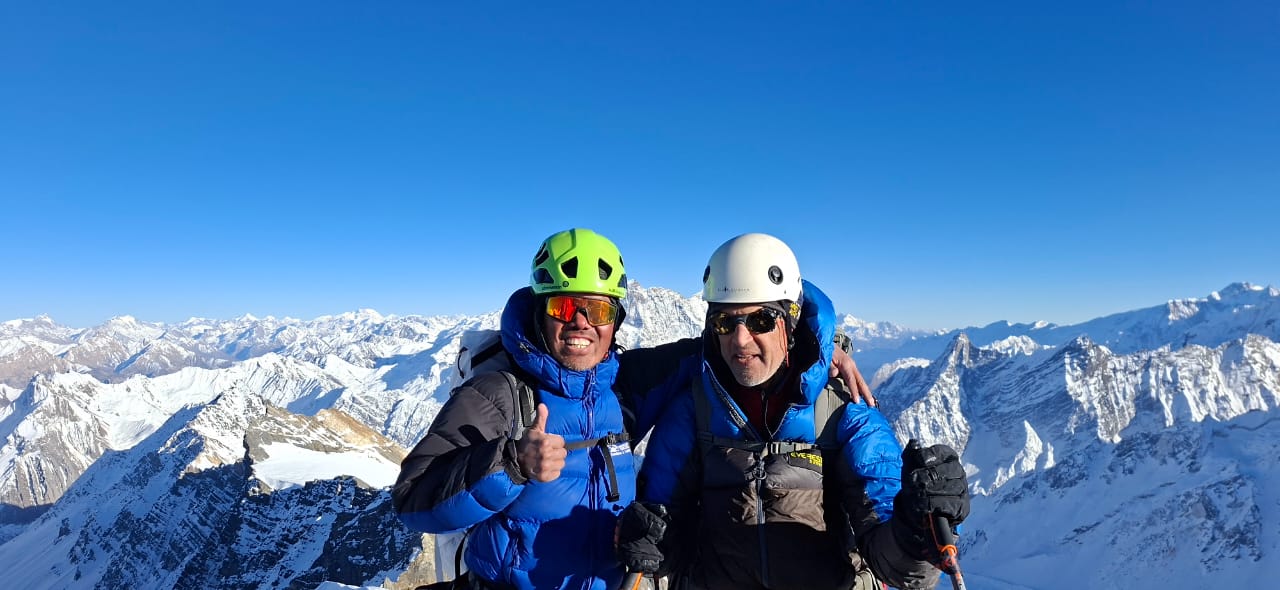LARKE PEAK CLIMBING
It is hard to imagine a greater sense of satisfaction than having slugged your way up a mountain and then to look down on the world below. This real climbing experience will give you that feeling. It will test your endurance and willpower and give you a true sense of achievement. You will be rewarded as you sigh with relief and stare down at some of the most magical scenery on earth. Secondly, you will feel overjoyed and be better prepared to face challenges in your life. Finally, you can shout out at the top of your voice, “I did it.”
Larke Peak (6219m) is in the Manaslu region of Nepal and has only recently been open to climbers. You can be sure of a less people and a more peaceful time while trekking through this incredible landscape.
Larke Peak Climbing (6219m) is home to Tamang and Sherpa people who are Tibetan Buddhists and some of the most calm and peaceful people on the planet. These people are devoted to the Dalai Lama. The Manaslu region is also home to the endangered snow leopard, red panda, Himalayan Black Bear, grey wolf, monkeys, musk deer, blue sheep and the ubiquitous Yaks that graze the alpine pastures. This is also a place where Nepal’s beautiful rhododendron tree grows and blooms in spring with white, pink and red flowers. The rhododendron is also Nepal’s native emblem and stands out in stark contrast to the green juniper, cedar and bamboo forests. There are believed to be 33 species of mammals, 110 species, and three species of reptiles and 1500-2000 species of flowering plants in this region.
The trek begins at Soti Khola and gradually heads to higher altitudes, initially heading to Larke La Pass (5135m) and then on to Larke Peak (6219m). At nearly every phase of this trek you will be astonished by the soaring snow-covered peaks and by the serene Tibetan villages as you head closer to the Tibetan border.
Sherpa Expedition Teams are not new to the trekking and climbing business, having been around for more than 40 years (Est. 1977), during which time their reputation has made them one of the most reliable and reputable companies in Nepal. Sherpa Expedition and Trekking put your safety first and manage every aspect of your journey – from airport pick up to departure, permits, meals and accommodation on the trek.
ITINERARY
Day 1 : Arrival in Kathmandu and transfer to hotel.
Welcome to Kathmandu, a city full of vibrant markets, bustling streets, colorful temples and grand pagodas. Our guide will meet you at the airport and take you to our hotel. The remainder of the day you will have an opportunity to familiarize yourself with the shopping areas closest to your hotel and catch up on shopping for equipment. In the evening, our tour guide will give you a brief introduction and provide valuable information about the trek.
Day 2 : Drive from Kathmandu to Soti Khola (800m) Duration: 6-7 hours.
We will take a public bus on this seven to eight hour road trip, stopping along the way for a lunch break. Tonight we will stay at Soti Khola near the river.
Day 3 : Trek from Soti Khola to Machha Khola (869m) Duration: 5-6 hours.
Our trek today traverses a mule track and ascends on a breathtaking path cut into the face of the cliff, then descends to Lapubesi (880m). Caution is required here! We then continue to Nauli Khola, crossing a suspension bridge on the way and then take the trail beside the Budi Gandaki River before reaching Machha Khola (900m). This so happens to be where many trekkers were stranded after the earthquake in 2015 and had to be rescued, Depending on current conditions, there is an alternative overnight stop in Kashi Gaun located on the east side of the river.
Day 4 : Trek from Machha Khola to Jagat (1340m) Duration: 6-7 hours.
Our route today follows the river to Khorlabesi and the tepid spring at Tatopani (meaning hot water) (930m), and then continues on the eastern bank of the Budi Gandaki River to Doban, Thulo Dunga and Yara Bagar (1370m). The trail zigzags across the river with several suspension bridges to cross before reaching the entrance gate to Manaslu Conservation Area and Jagat (1410m), with its unique flagstone village square. Permits are checked by authorities. Sherpa Expedition & Trekking will check that the route is passable, and may suggest we take an alternative route taking a much higher path on the east side of the river before descending to the old trail near Doban.
Day 5 : Trek from Jagat to Deng (2300m) Duration: 6-7 hours.
Above Jagat, the trail climbs to Salleri and Sirdibas before reaching Philim. The landscape becomes increasingly barren as the trail winds past several waterfalls until reaching a junction at Ekle Bhatti where the trail leads to Lokpa a village on the trail to the Tsum Valley. We then climb above the junction of the Buri Gandaki and Shar Khola Rivers and then head to Pewa and finally Deng (1860m). Many villages in this area suffered extensive damage in the 2015 earthquake.
Day 6 : Trek from Deng to Namrung (2700m) Duration: 6-7 hours.
Today we climb beyond the Tom (tum) Khola to Longa Chuta and then come into a captivating fir and rhododendron forest filled with birds and Langur monkeys located on the north side of the Buri Gandaki River. We then cross back to the other side of the river before reaching Namrung (2660m), an earlier customs post in the days when this was a route for transporting salt from Tibet. Namrung also suffered extensive damage from the 2015 earthquake, but today it has been restored to its previous charm.
Day 7 : Trek from Namrung to Samagaun (3520m) Duration: 6-7 hours
The trail today leads to Shyaula (5320m) where a substantial number of buildings were damaged in the 2015 earhtquake, including the Gompa (Buddhist temple).. We continue on passing through a number of valleys and trails before arriving at the more remote village of Gompas and continue to Sama Gaun(3530) - also known as Samagaun. The town boasts of several fascinating monasteries in the village.
Day 8 : Acclimatization day at Samagaun – trek to Manaslu Base Camp (4900).
At these higher altitudes it is necessary to get acclimatized, for at least one day, before attempting climbs to higher altitudes. Health specialists suggest that you move about and don’t sit idly. A good way to stay active is to explore the Gompa at Pugyen(4070m), a one day hike that leaves the trail between Syaula and Sama. If time permits, it is possible for you to carry on up this valley to the rugged rocks and terrain of the Pugin glacier. Another option is a trip to the lake at Birendra Tal (3450m) or a more demanding ascent to Manaslu Base Camp (4900m). It is believed that north of Birendra Tal is Milarepa's Cave (famous Buddha) claimed to have been used as a meditation retreat by the Buddhist saint.
Day 9 : Trek from Samagaun to Samdo (3875m) Duration: 3-4 hours.
Today the trail descends and heads back to the Buri Gandaki River passing the junction of Birendra Tal and Manaslu Base Camp. The valley expands before reaching Kermo Khadka and then continuing to the white Kani Gateway signaling the entrance to Samdo (3860m). If time permits we may trek to the peak above the village for impressive views of Mount Manaslu. If it is necessary to further acclimatize, there is a 6 to 7-hour trek climbing 640m to the moraine of the Fukang Glacier, where you will be rewarded with far-reaching views towards several passes used by locals to cross over into Tibet.
Day 10 : Rest and acclimatization day at Samdo
Again it is advisable to stay active to better prepare you for the higher altitudes. You may wander around the village of the venture to the nearby hills to take in the views.
Day 11 : Samdo to Dharamsala Larke Phedi (4460m) Duration: 4-5 hours.
A relatively short day sees us descending through fields prior to starting our climb towards the Larkya-La Pass, a trek offering dazzling views of Manaslu and the Syacha Glacier, and a likelihood of spotting Himalayan blue sheep on your trek to Dharamsala (4480m). This is as high as we go today without risking altitude sickness. This is the last safe haven before reaching the pass. This sector of the trek is often subject to snowfall and from mid-December to mid-March, when snow blocks the Larkya-La Pass, the Samdo Lodge is typically closed. Your guide will know in advance if the lodge is closed.
Day 12 : Trek from Samdo to Larke Peak Base Camp (5135m) Duration: 4-5 hours.
Today we have a short four to five-hour walk to Larke Peak Base Camp where we will stay overnight. It is this progressive climbing in small increments that helps you to overcome altitude sickness.
Day 13 : Day 13 & 14 - Climbing period and preparation.
Before the actual climb your guide will prepare you by going over safety procedures and the use of roping techniques. The prevailing weather conditions will greatly influence the climb to the peak. However, it is in your best interests that you are prepared for any eventuality. Your day on the peak will be the highlight of this trek. The physical exertion on getting to the peak will be rewarded by some of the most jaw-dropping views of the surrounding peaks. These memories will stay with you for a lifetime.
Day 14 - 15 : Reserve day in case of bad weather
It might happen that we may not reach the summit as we planned due to bad or unfavorable weather conditions. Our main target is to successfully lead you to the summit of Larke Peak. Thus, we will spare a reserve day in case of bad weather or other unwanted situations. However, if everything goes smoothly, we can use this day to trek back on leisure.
Day 16 : Trek from Larke Peak Base Camp to Bimtang (3800m), 5-6 hours.
Today we descend to Bimtang, a well known trading post along the Tibetan salt route. An appealing detour leads to a trail above Bimtang to the translucent glacial lake of Pungkar Tal (4100m). We will stay overnight at Bimtang.
Day 17 : Trek from Bimtang to Dharapani (1963m) Duration: 6-7 hours.
Today we descend to Dudh Khola and Soti Khola(2700m) also known as Khare, following a trail directly below the enormous Phunki Peak(6258m). We then take a trail across the ridge heading downhill to the river before reaching Gho village. At this lower altitude it is noticeable greener as we descend through cultivated fields and forests and take the trail on the north bank of the Dudh Khola before reaching Tilche (2300m) the largest village since leaving Samdo. The village is well known for its flagstone paved streets and the home of Gurung. After passing Tilche through the Kani (gateway arches) we, then cross the stream before reaching Thonje. The trail to Dharapani (1920m) requires crossing a suspension-bridge over the Marsyangdi river. We are soon at the junction of the Annapurna Circuit trek where the going gets easier before descending to Bensi Sahar and ultimately Kathmandu.
Day 18 : Trek from Dharapani to Syange (1100m) Duration: 5-6 hours.
We will today continue heading downhill until reaching tonight’s destination, Syange, where we will stay overnight.
Day 19 : Drive from Syange to Besisahar & to Kathmandu; Duration: 6-7 hours.
We have a short drive to Besisahar and then a road trip back to Kathmandu. On arrival, you will be taken to your hotel.
Day 20 : Transfer to International airport.
You will leave Nepal, but will never forget this great adventure and the laughs you shared on this journey to some of the world’s most spectacular peaks. A Sherpa Expedition and Trekking representative will drop you off at the airport approximately 3 hours before your scheduled flight.
SERVICES
Cost Included in your package
- Arrival and departure transfer services to international flights as per itinerary.
- Kathmandu to Soti Khola and Beshisahar to Kathmandu transportation By Bus.
- 2 Nights hotel accommodation in Kathmandu including breakfast.
- Tea House + Camping combined accommodation during the trek – as per itinerary Tea House + Camping combined accommodation during the trek – as per itinerary
- Experienced and government licensed high altitude trekking guide during the trekking and climbing period
- Three meals a day (Breakfast, lunch, and dinner) during the trek.
- Fresh fruit every evening after dinner.
- Strong, helpful Sherpa porters with proper safety equipment and walking equipment, his salary, food, accommodation, and insurance (one porter for two people).
- Trekking permit (Manaslu Conservation area (MCAP & ACAP)
- TIMS card (Trekking Information Management System).
- Larke Peak Climbing Permit
- First aid medical kits for the group and the staff.
- Use of sleeping bag, down jacket, duffel bag and walking poles (if you don’t have your own, to be returned after trip completed).
- Helicopter rescue insurance for high altitude staff.
- Sherpa Expedition and Trekking T-shirt
- Oxygen meter to check your pulse and oxygen saturation and heart rate twice daily (Very useful to check Altitude Mountain Sickness(AMS) symptoms) which will ensure your health during the trek.
Costs Exclude
- Meals whilst you are in Kathmandu - lunch, and dinner.
- Nepal entry visa fee (easy to obtain the visa on arrival at Tribhuvan International Airport – Kathmandu). $30 USD for 15-day, $50 USD for 30 Days, and $125 USD for 90 Days visa.
- Personal travel and medical insurance.
- Personal Climbing Gears
- International airfare.
- Your personal expenses.
- All the alcoholic and nonalcoholic, soup, tea, coffee, hot chocolate, cocoa, mineral water, extra food, cold and hot drinks on trek ( i.e. those you choose to purchase along the way and during evenings in the tea houses)
- All desserts & sweet things like chocolate, cake, pie, pudding.
- Hot shower and battery charging at the tea houses.
- Tips for the guide, porter, and driver (tipping is expected)
- NOTE: If you return earlier from the trek due to sickness or any problem, the money you paid for the flight, hotel, mountain room, food, etc. is nonrefundable, and you will need to bear the expenses for the hotel, food, etc. in Kathmandu yourself.
EQUIPMENTS
You will be carrying all of your gear and share some of the cluster gear. Keeping your pack light is important, so choose light-weight clothing and equipment. Be sure to have a range of clothing suitable for all conditions. Sudden change of weather may require layering of clothing. Three layers will meet your needs. Avoid cotton or fabrics that do not maintain heat when cold. Comfortable durable wool (or proven fabrics) that breathe and expel sweat lends itself to an additional pleasant experience!'
We will offer complimentary water and a windproof duffle that you'll use on the trek - carried by porters. The duffle is yours to keep once at the end of the trek. You can safely leave your bag, together with your non-trekking requirements, at our office in Katmandu and collect them upon your return.
All equipment, such as base camp tents, room accessories, climbing rope, ice screws, snow bar and ice hammer is provided by Sherpa Expedition & Trekking.
Upper Body:
- Base Layers: Moisture-wicking and quick-drying shirts and thermal tops.
- Insulation Layers: Fleece or down jackets to provide warmth.
- Waterproof Shell Jacket: A durable and breathable jacket to protect against wind and rain.
- Softshell Jacket: A lightweight and water-resistant jacket for added protection.
- Climbing Harness: A comfortable harness to secure yourself to the rope.
- Helmet: A strong and well-fitting helmet to protect your head from falling objects.
- Gloves: A combination of lightweight liner gloves and insulated gloves or mittens for warmth and dexterity.
- Buff or Neck Gaiter: To protect your neck and face from cold and wind.
- Sunglasses: Polarized and UV-protected sunglasses to shield your eyes from the sun and snow glare.
- Goggles: Ski or mountaineering goggles for added eye protection in extreme weather conditions.
Lower Body:
- Base Layers: Moisture-wicking and quick-drying thermal bottoms.
- Insulation Layers: Fleece or insulated pants for added warmth.
- Waterproof Shell Pants: Durable and breathable pants to protect against wind, rain, and snow.
- Softshell Pants: Lightweight and water-resistant pants for added protection.
- Mountaineering Boots: Sturdy and insulated boots designed for snow and ice.
- Crampons: Attachable spikes that provide traction on icy terrain.
- Gaiters: Waterproof and breathable gaiters to keep snow out of your boots.
- Socks: A combination of moisture-wicking liner socks and thick, warm mountaineering socks.
Other Essential Items:
- Backpack: A spacious and sturdy backpack to carry your climbing gear and personal belongings.
- Sleeping Bag: A warm and lightweight sleeping bag that can withstand sub-zero temperatures.
- Trekking Poles: Adjustable trekking poles for added stability and support.
- Headlamp: Essential for climbing in low-light or dark conditions.
- Water Bottles: Insulated water bottles to keep your water from freezing.
- Sunscreen: High SPF sunscreen to protect your skin from the strong sun at high altitudes.
- First Aid Kit: A comprehensive first aid kit with essential medications and supplies.
- Climbing Snacks: Energy bars, nuts, and other lightweight snacks for quick fuel during the climb.
It is important to invest in high-quality gear and ensure that everything fits properly and is in good condition. Additionally, consult with experienced climbers or a professional guide to ensure you have all the necessary gear and receive proper training on how to use it effectively and safely.
GOOD TO KNOW
Larke Peak Climbing, also known as Larkya Peak Climbing, is a popular trekking peak located in the Manaslu region of Nepal. Here are some important details you should know about this climb:
1. Permit: To climb Larke Peak, you will need a climbing permit from the Nepal Mountaineering Association (NMA). You will also need to obtain a Manaslu Conservation Area Permit (MCAP) and an Annapurna Conservation Area Permit (ACAP) since Larke Peak lies within these conservation areas.
2. Difficulty: Larke Peak is considered a technically challenging climb, requiring moderate to advanced mountaineering skills. It involves steep slopes, icy sections, and potentially challenging weather conditions. Prior mountaineering experience is recommended.
3. Altitude: The summit of Larke Peak stands at an elevation of 6,249 meters (20,505 feet). Acclimatization is crucial to avoid altitude sickness, so it is recommended to spend several days acclimatizing during the trek.
4. Duration: The Larke Peak Climbing expedition typically takes around 16-18 days, including the trek to and from the peak. This duration allows for acclimatization and ensures a safer climb.
5. Trekking Route: The Larke Peak Climbing route usually starts and ends in the town of Soti Khola, following the Manaslu Circuit Trek. The trek takes you through beautiful landscapes, remote villages, and stunning mountain views.
6. Guide and Porter: It is highly recommended to hire an experienced guide and porters for Larke Peak Climbing. They will assist you with navigation, carry heavy loads, and provide necessary support throughout the expedition.
7. Equipment: Proper mountaineering equipment is essential for Larke Peak Climbing. This includes crampons, ice axes, harnesses, ropes, helmets, and appropriate clothing for cold weather conditions. It is advisable to rent or bring your own gear from home.
8. Weather: The best time to climb Larke Peak is during the spring (March to May) and autumn (September to November) seasons. These months offer stable weather conditions, clear skies, and better visibility.
9. Accommodation: During the trek, you will find teahouses and lodges along the route, providing basic accommodation and meals. However, higher up on the mountain, camping is required for the Larke Peak climb.
10. Safety: Safety should always be a top priority during Larke Peak Climbing. It is crucial to follow the guidance of your guide, maintain proper acclimatization, and be prepared for emergencies with a first aid kit and communication devices.
Remember, Larke Peak Climbing requires physical fitness, stamina, and mountaineering skills. It is recommended to undergo proper training and preparation before attempting this climb.
MAP
PHOTOS/Videos
Departures
Select a departure month
Fill out the form below and a Travel Expert will reach out to create your perfect tour.
FAQS
Is Larke Peak Climbing suitable for beginners?
Larke Peak Climbing is not recommended for beginners. It requires prior mountaineering experience and technical skills due to its challenging nature.
Do I need a climbing guide for Larke Peak Climbing?
It is highly recommended to hire an experienced climbing guide for Larke Peak Climbing. They will ensure your safety, provide guidance, and assist with technical aspects of the climb.
How much does it cost to climb Larke Peak?
The cost of Larke Peak Climbing varies depending on several factors, such as the duration of the expedition, the number of climbers, and the services included. It is best to consult with trekking agencies to get accurate pricing information.
Can I climb Larke Peak independently?
Technically, it is possible to climb Larke Peak independently. However, it is strongly advised to have prior mountaineering experience and be well-prepared with the necessary equipment, permits, and knowledge of the route.
What permits do I need for Larke Peak Climbing?
To climb Larke Peak, you will need a climbing permit from the Nepal Mountaineering Association (NMA). You will also require a Manaslu Conservation Area Permit (MCAP) and an Annapurna Conservation Area Permit (ACAP) as the peak lies within these conservation areas.
What is the best time to climb Larke Peak?
The best time to climb Larke Peak is during the spring (March to May) and autumn (September to November) seasons. These months offer stable weather conditions, clear skies, and better visibility.
How physically fit do I need to be for Larke Peak Climbing?
Larke Peak Climbing requires a good level of physical fitness and stamina. It involves long days of trekking and challenging mountaineering sections. Prior training and preparation, including cardiovascular exercises and strength training, are recommended.
Are there any age restrictions for Larke Peak Climbing?
There are no specific age restrictions for Larke Peak Climbing. However, climbers should be in good health and have the necessary physical fitness and mountaineering skills to undertake the climb.
Are there any rescue services available on Larke Peak?
In case of emergencies, there are rescue services available in the Manaslu region. It is important to have adequate travel insurance that covers helicopter rescue services.
What equipment do I need for Larke Peak Climbing?
You will need proper mountaineering equipment, including crampons, ice axes, harnesses, ropes, helmets, and appropriate clothing for cold weather conditions. It is advisable to rent or bring your own gear from home.
Latest Traveller’s Reviews
Travel experiences of our clients who recently returned from their trips.
100%
Based On 9 Reviews
Valeria Buga
Finland
October 17, 2023
Immersed in the Majestic Himalayan Environment
One of the highlights of our Larke Peak climbing experience was being immersed in the majestic Himalayan environment. From the pristine mountain wilderness to the serene alpine landscapes, the journey allowed us to truly appreciate the grandeur of nature.
John David
Australia
May 17, 2023
Unforgettable Moments and Unparalleled Beauty
The Larke Peak climbing expedition created unforgettable moments and offered unparalleled beauty. The combination of challenging climbs, stunning vistas, and the sense of achievement made it an adventure that surpassed all expectations.
Reynnier Mendoza
United States
April 14, 2023
Sense of Accomplishment and Triumph at the Summit
Reaching the summit of Larke Peak was an incredible moment of accomplishment and triumph. The panoramic views from the top, with the surrounding Himalayan peaks stretching out before us, made all the hard work and perseverance worthwhile.
People Considering This Package Right Now Check availability



























